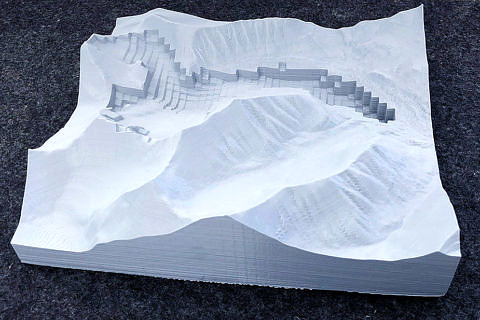Recalculating glacier ice volumes

FAU geographer contributes to global study with formula for determining thickness of glaciers
An international team of glaciologists headed by ETH Zürich and the Swiss Federal Institute for Forest, Snow and Landscape Research (WSL) and including scientists from Friedrich-Alexander-Universität Erlangen-Nürnberg (FAU) have provided a new estimate for the volume of ice in glaciers throughout the world, excluding the Greenland and Antarctic ice sheets. Their conclusion: previous calculations overestimated the volume of the glaciers in High Mountain Asia. They have published their findings in the journal Nature Geoscience.
Climate change is causing glaciers to shrink around the world. Reduced meltwaters from these glaciers also have downstream effects, particularly on freshwater availability. A lack of meltwater can greatly restrict the water supply to many rivers, especially in arid regions such as the Andes or central Asia, that depend on this water source for agriculture. Up-to-date information on the worldwide ice volume is needed to assess how glaciers – and the freshwater reserves they supply – will develop, and how sea levels are set to change.
Ice thickness calculated for 215,000 glaciers
The team of researchers used a combination of different numerical models to calculate the ice thickness distribution and the ice volume of some 215,000 glaciers around the world. The researchers excluded sea ice and glaciers that are connected to the Greenland and Antarctic ice sheets from their calculations.
According to the study, the combined ice volume of all considered glaciers currently amounts to some 158,000 cubic kilometres. The last available estimate – dating a few years ago – was around 18 percent higher. The largest glacier ice masses (some 75,000 cubic kilometres) are found in the Arctic and account for almost half of the global glacier ice volume. They include glaciers in both the Canadian and the Russian Arctic – such as those found on Baffin Island and the Novaya Zemlya archipelago – as well as glaciers along the Greenland coast and the Norwegian island of Spitsbergen.
Glaciers retreating faster than thought
Together with Alaska, High Mountain Asia (that is the region including the Himalayas, the Tibetan Plateau and the mountains in central Asia) is home to the largest ice masses outside the Arctic, accounting for a volume of 7,000 cubic kilometres in total. The study indicates that previous calculations overestimated this volume by almost a quarter.
‘In light of these new calculations, we have to assume that glaciers in High Mountain Asia might be disappearing more quickly than we thought so far,’ says Daniel Farinotti, Professor of Glaciology at the Laboratory of Hydraulics, Hydrology and Glaciology (VAW) at ETH Zurich and at the WSL.
Previously, researchers had estimated that the area covered by glaciers in this region would halve by the 2070’s. This is now expected to happen in the 2060’s – with perceptible consequences for local water supplies. The glaciers of High Asia feed into large rivers, including the Indus, the Tarim and rivers feeding into the Aral Sea. Hundreds of millions of people depend on them.
Meltwater volumes set to diminish by up to a quarter
Depending on the model used, researchers expect summer meltwater volumes in the above regions to be as much as 24 percent lower by the end of the century than they are today. ’This difference is worrying. To get a more accurate estimation of the full extent, we would need better measurements of the regional glacier volumes,’ Farinotti says. As things stand, only very few measurements are available for the ice thickness of glaciers in the region, making it harder to calibrate the models.
Based on their calculations, the researchers also deduced that if the glaciers were to melt away completely, the glaciers – or rather their meltwater – could cause global sea levels to rise by up to 30 centimetres. Between 1990 and 2010, glacier melt contributed to rise sea levels by about 1.5 centimetres.
For their analysis, the researchers used a combination of up to five independent numerical models. In these models, several sources of information – including the glacier outlines derived from satellite images and digital elevation models of the glacier surface – were combined with data about the glaciers’ flow behaviour. ‘This allows us to infer the spatial distribution of the ice thickness,’ the ETH professor explains. To calibrate the models, the team also used glacier ice thickness measurements. However, such measurements are currently only available for about 1,000 glaciers, Farinotti says.
Accurate estimates of ice volume in spite of few points of measurement
One of the five models was provided by Dr. Johannes Fürst from the Institute of Geography at FAU. His approach is useful when only a few direct points of measurement of the thickness of the glacier are available, as is so often the case. Starting from a certain point of measurement, the probable margin of error for the thickness of the ice can be calculated by taking the rate of flow and direction and the increase and decrease in mass of the glacier into consideration.
The geographer from FAU based his approach on research conducted in the Spitsbergen archipelago and the approximately 1,700 glaciers found there. He pooled measurements of ice thickness ranging from the 1980’s until the present day. The data has been collected over the years by various research teams. Now, in the present study, the more than one million points of measurement helped determine the volume of the ice and its distribution more accurately. Fürst came to the conclusion that the total volume of ice in the archipelago is considerably less than previously presumed.
During the study, researchers from ETH and the WSL worked in collaboration with scientists from the Universities of Zurich, Fribourg, Erlangen-Nürnberg and Innsbruck, and partners at the Indian Institute of Technology Bombay.
Further information:
Dr. Johannes Fürst
Phone: + 49 9131 85-26680
johannes.fuerst@fau.de